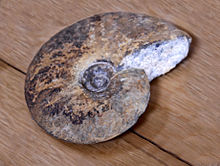
Dactylioceras was a widespread genus of ammonites from the Lower Jurassic period, approximately 180 million years ago (mya).
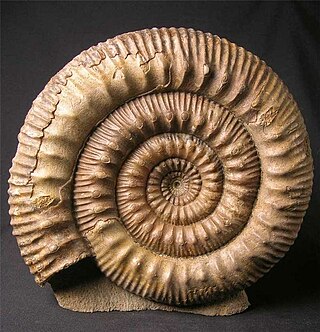
Stephanoceras is an extinct genus of Stephanoceratoid ammonite which lived during the Bajocian. It is the type genus of the family Stephanoceratidae.
Abbasites is an extinct genus of ammonites from the early Middle Jurassic epoch, included in the ammonitid family Erycitidae.

Audaxlytoceras is an extinct genus of lytoceratid ammonites.
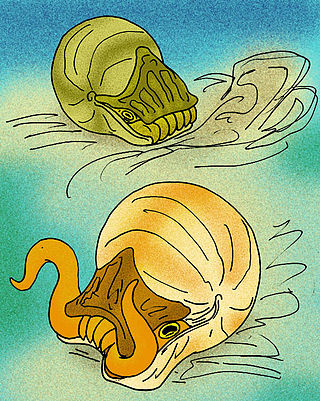
Arcestes is a genus of extinct ceratitid ammonites found in Triassic-aged marine strata.

Arnioceras is an extinct genus of large, evolute, discoidal ammonite from the Lower Jurassic. The shell is normally coiled so that all whorls are exposed. Sides bear strong sharp ribs that are straight until reaching the ventrolateral edge where they swing forward and fade. The rim (venter) is keeled and free of grooves.
Balticeras is an involute, discoidal Upper Jurassic (Oxfordian) ammonite found in England, Germany, and Switzerland, belonging to the Perisphinctidae. The shell is strongly embracing, tending to be oxyconic. Sides are gently curved, converging on a narrow to sharp ventral rim.

Gleviceras is an ammonite genus that lived during the Early Jurassic Period, found in Canada, Hungary, Mexico and the United Kingdom.
Euaptetoceras is an evolute hildoceratoid ammonite from the lower Middle Jurassic, included in the family Hammatoceratidae and the subfamility Hammatoceratinae. The genus may be a junior synonym for Eudmetoceras of Buckman, 1920.

Hyperlioceras is an extinct genus of cephalopod included in the ammonitid family Graphoceratidae that lived during the Bajocian stage of the Middle Jurassic. The type species is Hyperlioceras discites
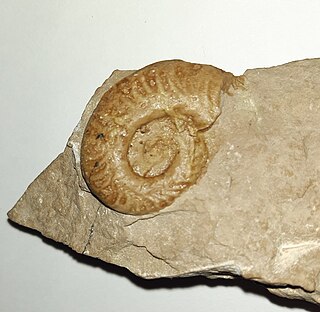
Hildoceras is a genus of ammonite from the Jurassic period in the family Hildoceratidae. The shells are characterized by a narrow discoidal evolute shape, keeled venter, concave ribs along the outer flanks, and a shallow spiral groove running along smooth inner flanks. Whorls slightly overlap, cross sections are compressed. The ventral keel is bordered on either side by a shallow groove. The genus was named by Alpheus Hyatt after Saint Hilda in 1876.
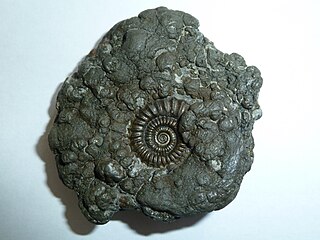
Promicroceras is an extinct ammonite genus from the upper Sinemurian of Europe, named by Leonard Spath in 1925. Promicroceras is included in the family Eoderoceratidae, which is part of the ammonitid superfamily Eoderoceratoidea.

Psiloceras is an extinct genus of ammonite. Psiloceras is among the earliest known Jurassic ammonites, and the appearance of the earliest Psiloceras species form the definition for the base of the Jurassic. Unlike most earlier ammonites, which had complex shell shapes and ornamentation, Psiloceras had a smooth shell.
Eoderoceras is an evolute, round whorled ammonite from the Lower Jurassic with an outer row of distinct spines, and in some, an inner row of tubercles, on either side; ribs only on the inner whorls.
Crucilobiceras is an ammonoid cephalopod genus from the Lower Jurassic belonging to the eoderoceratoidean family Eoderoceratidae. Cruciliboceras has an evolute shell, such that all whorls are well exposed, with persistent radial ribbing and with spines or tubercles on the outer, ventral, rim, and in some, tubercles in the inner, umbilical, rim. The genus Crucilobiceras is commonly found along the Jurassic Coast of England.

Calliphylloceras is an ammonite belonging to the Phylloceratidae.

The family Dactylioceratidae comprises Early Jurassic ammonite genera with ribbed and commonly tuberculate shells that resembled later Middle Jurassic stephanoceratids and Upper Jurassic perisphinctids. Shells may be either evolute or involute.

Echioceratidae is an extinct family of ammonites that lived during Sinemurian stage of Early Jurassic.

Harpoceratinae is an extinct subfamily of cephalopods belonging to the family Hildoceratidae. Ammonites of this subfamily had involute and compressed shells with strong keels. Keel might be rarely missing, but this is considered to be an abnormality. This has been observed both in Cleviceras and Harpoceras and called as genus Monestieria, which is now known to be invalid. Another example is Pseudolioceras, whose unkeeled specimen was used as type for description of invalid genus Praehaploceras. Oxyconic forms of this subfamily does not have any keel. Ribs were single, but in some genera also bifurcating with shapes from sigmoidal to falcate. Sometimes, shell can have only striate ribs or is smooth. Tubercules are rare. Dimorphism is known in some genera and it is observable mostly in size. Macrochons can be 4, to 6 times larger than microconchs. As an example, macroconchs of Pseudolioceras are more than 150mm in diameter, while adult microconchs are only 35-50mm. There are big size differences even within dimorphs. Specimens ca be 2, or sometimes even 3 times bigger than other specimens of same dimorph.

Hammatoceras is a genus of ammonites belonging to the family Hammatoceratidae which lived during the Toarcian stage of the Early/Lower Jurassic between about 184 and 175 million year ago.
